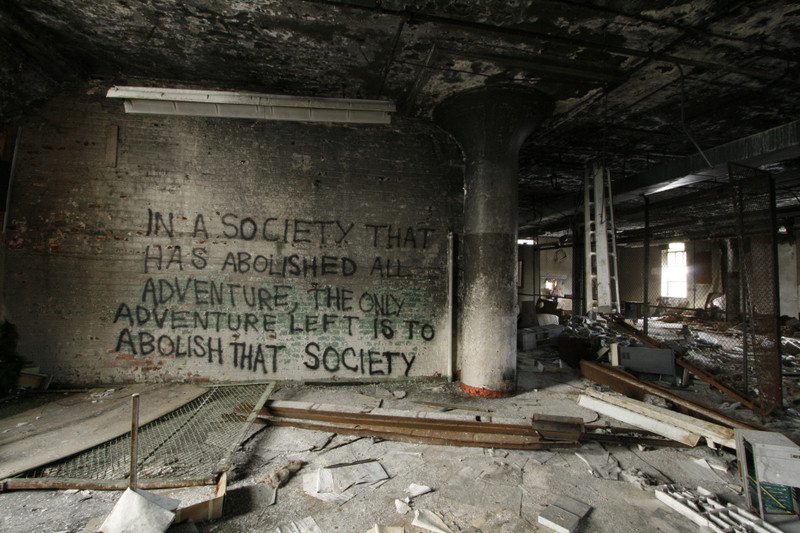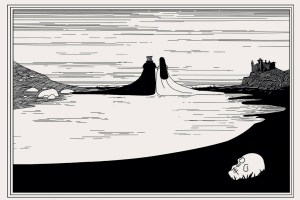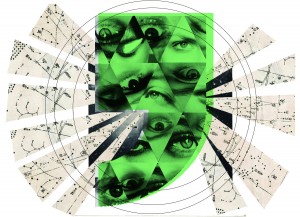
Psychogeography: An Idea for the New Year
by Harrison Fannon | December 30, 2016
In pursuit of mental clarity I once went into a floatation tank. As I drifted into bodiless consciousness under sensory deprivation, I noticed that what was left buried deep under the sediment of my busy mind was not my innermost spiritual being but rather corporate logos, advertising slogans and moving images of the commercial world. I had excavated the depths of my own consciousness only to find it infested by the inexorable, flashing faces of our consumer culture.
On a personal level this experience was alarming, but it indicates the ubiquity and relentlessness of the spectacle that we perceive everyday. A spectacle predicated on consumption and commodity fetishism, that was once confined to urban space but is now presented to us in virtual space as well. On the commercial streets of the urban environment, bodies become commodities. We are footfall, and that is all in the eyes of the corporations who feed us images of a life we could have, if only we bought their product. In the echo chamber of the internet we are presented with a reality based on algorithms. Algorithms concerned with selling us products based on what we have clicked on in the past. In both spaces we are turned into alienated desiring machines. Nihilism, boredom and solipsism all become symptoms of the individual bombarded by the unceasing torrent of commercialism. In the hazy anoesis one looks back on this world of images at a distance and finds it meaningless.
But rather than sitting back and contemplating the meaninglessness in despair, one can be active. Call it active nihilism perhaps, and history is rife with its practitioners. An excellent example lies in the the neo-marxist Parisien art movement The Situationist International. This group of intellectuals and artists took aim at the modern capitalist system in the middle 20th century, and their ideas were influential in inspiring the student protests of May 1968. It’s central intellectual figure, Guy Debord, described and critiqued the nature of society in his searing and insightful Society of the Spectacle (1967), in which the concept of the spectacle was refined. In spectacular society he comments: “all that was once directly lived has become mere representation”, with Debord claiming that what he was witnessing was the “historical moment in which the commodity completes its colonisation of social life”. The SI provided numerous antidotes to the bleak and misanthropic nature of society they found themselves in. However it is Debord’s idea of psychogeography that has retained a sense of timeless worth and is more relevant today in its scope than ever before.
On the theoretical level, this is the intersection of psychology and geography — the environment’s influence on the emotions and behaviour of the individual. On the practical level, Debord suggests the derive — the drift. This drifting through urban space encourages the individual to walk around the city, following the path of least resistance, noticing the sudden changes in ambiences in mere meters on the streets and responding to the appealing or repelling character of certain places. The derive is playful creation. It is a passionate journey through a rapid changing of ambiences — a life in step with active adventure. The very act of walking with your feet, shunting other modes of transport that herd us from one place of consumption to the other is revolutionary in itself. In this way, the individual undermines the hierarchical organisation of the city. An organisation that siphons off city dwellers into controlled streams of urban movement. The body as commodity is removed from the abstract nowhere of the spectacle and redefined — resituated, glowing with life. In times of nihilistic passivity, the modern wanderer perceives their environment through their own eyes, expressing total insubordination to habitual influences. The practise of psychogeography has the potential to facilitate a vital and liberatory mode of urban being.
Psychogeography leads to a renewal of perception. The urban environment becomes defamiliarised and at the same time one becomes more aware of their position in the spaces they are situated in. With revitalised eyes, one becomes increasingly conscious of the aesthetics which dominate the spectacle of our society. In our city of Oxford, we are surrounded by a juxtaposition of historical, academic buildings, public monuments and commercial high street shops. The urban space is composed of buildings that represent the aesthetics of our society, the values of our culture, the lingering remains of our history. The statue of Cecil Rhodes is one such monument. The RMF movement is thus, in the spirit of the Situationist International, an attack on the aesthetics of the society represented by Rhodes. It is an iconoclastic protest of a public monument — a monument which binds us to a colonial history and the hierarchical organisation of society. The movement embodies an awakened perception of the physical environment by exposing the meaning held within its monuments. It is such active protests that refocus the glazed eyes of the bourgeois populace and unleash an awakened, passionate reconnection with the real. Here, aesthetics become the essential political medium of the student protest.
In the 21st century, far from what Debord could have imagined, the urban space is no longer the dominant platform for human sociability. The construction of the World Wide Web has meant the creation of new spaces for humans to project life and meaning onto. This infinite space, that at first appears free from oppression, societal prejudices and hierarchy, has facilitated the construction of endless online communities — communities that could not have existed in physical space. For a moment it would have seemed like the internet provided the utopian, anarchic, egalitarian platform on which activism could thrive. However, hijacked by the same capitalistic values that dominate the urban space, the Word Wide Web has become a dehumanised space of commerce, work and diversionary entertainment. It is increasingly becoming part of the spectacle rather than a challenge to it.
Clicktivism, the internet generation’s preferred method of activism, provides nothing more than the illusion of effective social dissent. In reality, clicktivism plays into the hands of the very same dominating structure, the same marketing model that most activists seek to revolt against. The whole internet experience is algorithmically tailored by corporations dipping into the seemingly endless pot of information gathered about you by Big Data. At the same time you can be sure that URLs, port numbers and IP addresses are instantly locating your whereabouts. The human endeavor in the virtual space seems to be leading ominously to a dead end.
In times of increasing surveillance coupled with the suffocating omnipresence of consumerism, psychogeography can provide a vivification to everyday life. Debord had envisioned his theories and practises to bring the capitalist spectacle to its knees, my suggestion, is perhaps more modest. The real pursuit lies in inhabiting the physical world around us with refocused eyes. It is actively engaging in space rather than becoming mere ghosts, passively shifting through the capitalist machine.
Psychogeography can be a vehicle to elude the aesthetic tyranny of our society whilst reassembling it with our own art and values. This may not be for the no-bullshit materialists out there as it deals with the minute, intangible tweakings of perception. But it is the most discreet of perceptual changes that can have monumental impacts.
The spectacle will only exist insofar as we continue to be spectators.




